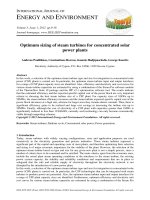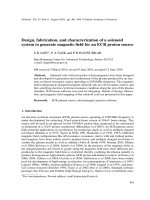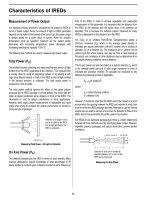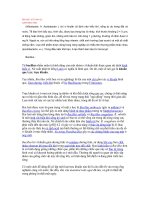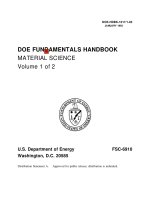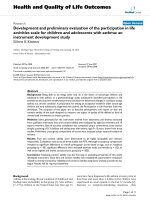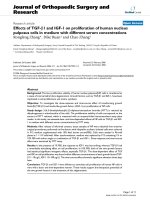Airplane design 1 - preliminary sizing of airplanes pptx
Bạn đang xem bản rút gọn của tài liệu. Xem và tải ngay bản đầy đủ của tài liệu tại đây (118.57 KB, 12 trang )
AE 440A Aerospace Vehicle Design: Aircraft
FALL SEMESTER 2008
3-4:20 PM: Tuesdays/Thursdays at 163 Everitt
Department of Aerospace Engineering
University of Illinois at Urbana-Champaign
Professor Eric Loth
321C Talbot Lab
Phone: 244-5581 e-mail:
Course Description
Introduction to the design of aerospace flight systems. The principles of systems
engineering, as they apply to the design process, are presented. A general design
methodology is introduced. These concepts are then applied to the initial sizing of both
aircraft and spacecraft systems. Involves intensive technical writing and technical
communication skills. 3 hours credit.
Teaching Assistants
Michael Behrens 315 English Bldg (402) 659-6963
Alex Ghosh 319C Talbot Lab (217)-721-2875
Phil Martorana 302E Talbot (815)-222-2289
Projected Area Specialties (for Written & Oral Reports)
Behrens writing and oral composition and report integration
Ghosh stability & control, performance, configurations
Martorana structures, aerodynamics, propulsion
Tentative
Office Hours for EL: 4-5:30 PM Wed & Fri and by appt.
Office Hours for AG: 4:30-6PM Tues & Thur and by appt.
Office Hours for PM: 4:30-6PM Mon & Wed and by appt.
Office Hours for MB: 10-11AM Mon, by appt, and after some 440 classes in 302 E Talbot
If you need accommodations for a learning or physical disability, please see me ASAP.
Course Handout Attachments:
• Aircraft Design Project Overview
• Grading Breakdown
• Course Schedule
• Reading Assignments & Reserve Books at Library
• Discipline Responsibilities
• Oral and Written Report Guidelines
2
Aircraft Design Courses Overview
1
st
part of AE 440:
Initial Design Concept
Learn preliminary weight sizing and constraint analysis. This defines the initial
point design (defined by weight, wing-loading, thrust-weight ratio, etc.) and vehicle
configuration. Give written reports and presentations on a subject related to your
area of interest and related to the team design project.
2
nd
part of AE 440:
Review Relevant Existing A/C
Æ
Determine Vehicle Concept
From teams and review Team Design Project in detail. Consider candidate vehicle
configuration based on historical and projected designs. From morphology process
reduce to three primary design and select lead design concept. For selection,
consider pre-determined theme and performance goals; but adjust as needed. This
work will culminate in a Concept Report (CR) and Concept Presentation (CDP)
1
st
part of AE 441:
Develop analysis tools and determine overall aircraft sizing and configuration
Develop team-consistent sub-system analysis tools and using them to improve the
design. This will end with an approximate sizing of all major dimensions. After this
part, your configuration can not change but your sizing can change. Develop
compatible tools for inter-disciplinary optimization. This work will culminate in a
Preliminary Design Report (PDR) and Preliminary Design Presentation (PDP)
2nd part of AE 441:
Detailed Analysis and Detailed Optimization
Advanced sub-system analysis computational tools shall be developed and used.
Detailed optimization (e.g. of wing span, cruise altitude, wing location, etc.) should
be refined/finalized with analysis tools among various disciplines. This work will
culminate in a Final Design Report (PDR) and Final Design Presentation (PDP)
3
AE 440 – Fall 2008
Aerospace Vehicle Design
GRADING
(%)
• Class Participation 10
• Initial Sizing Homework 10
• Constraint Analysis Homework 10
• Individual Research Presentations (avg. of instructor scores) 10
• Individual Research Reports (avg. of instructor scores) 10
• Concept Report (avg. of instructor scores) 25
• Concept Presentations 15
• Peer Evaluations of 2
nd
part of 440 (avg. of team-mate scores) 10
100%
Report and Presentation grades will be based upon organization, clarity of presentation,
originality, technical soundness, depth of analysis, and overall integration.
For final written presentation reports: 75% Individual + 25% Team
Misc. Notes:
1. Reports will be reduced by 1% for every ten minutes late. Plan for contingencies!
2. Everyone must attend both classes every week and all the presentations. The only
exception is an excused absence by me for serious conflicts (e.g. health reasons and
job interviews).
I look for natural breaks in the grade distribution for grading, but curved (if needed) to ensure at
least 1/3 of class gets an A
+
,A or A
-
type of grade.
4
AE 440 – Fall 2008 Course Schedule
Aug. 26 T Course Introduction
Aug. 28 Th Sample AE 441 Presentation & Design Concepts & Overall Process
Sept. 2 T Initial Sizing Theory I
Sep. 4 Th Initial Sizing Theory II
Sep. 9 T Constraint Analysis Theory I (Discipline/Team Choices Due)
Sep. 11 Th Constraint Analysis Theory II (Initial Sizing HW Due) & Teams Fixed
Sep. 16 T Constraint Analysis Theory III
Sep. 18 Th Written Research Report Guidelines by Loth - Determine Leader & Specialties
Sep. 23 T Discipline Lectures
Sep. 25 Th Discipline Lectures & Team Meetings (Constraint Analysis HW due)
Sep. 30 T Discipline Lectures & Discipline Meetings
Oct. 2 Th Written Report Guidelines by Behrens & Team Meetings
Oct. 7 T Oral Report Guidelines by Behrens & Loth, Presentation Dates/Order Assigned
Oct. 9 Th Q/A on Discipline Areas & Team Meetings (Written Research Reports due)
Oct. 14 T Individual Research Presentations (1/2 class) Class 3-5:50PM 1109 Siebel Center
Oct. 16 Th Individual Research Presentations (1/2 class) Class 3-5:50PM
Oct. 21 T Team Meetings to Determine Design Theme (& Consider Concepts)
Oct. 23 Th Team Meetings to Discuss Initial Concepts
Oct. 28 T Team Meetings to Finalize Candidate Design Concepts
Oct. 30 Th Team Meetings to Group Concepts in terms of Morphology
Nov. 4 T Team Meetings to Finalize Top Three Design Concepts
Nov. 6 T Team Meetings to Analyze Top Three Design Concepts
Nov. 11 T Team Meetings to Finalize Top Design Concept
Nov. 13 Th Final Reports Discussion & Team Meetings to Organize Presentations
Nov. 18 T Team Concept Presentations (1/2 of teams) Class to 3-5:50PM 1109 Siebel Center
Nov. 20 Th Team Concept Presentations (1/2 of teams); Class to 3-5:50PM
Fall Break
Dec. 2 T Written Report Guidelines, Team Meetings to Organize Written Report
Dec. 4 Th Team Meetings to Organize Written Report & Incorporate Feedback
Dec. 9 T Team Meetings Final Report Due Dec. 9 5 PM
5
AE 440 – Fall 2008
Aerospace Vehicle Design
READING ASSIGNMENTS IN RAYMER (3rd Ed)
All Groups: Chaps. 1-3, 6
Aero: Chaps. 4, 5, 7, 12
S&C: Chaps. 16, 17
Performance: Chap. 17
Propulsion: Chaps. 5, 10, 13 (also Chapter 8 Oates)
Structures: Chaps. 8, 11, 14
Config: Chaps. 7, 8, 9, 15, 18
Cost: Chaps. 18, 19
Grainger Engineering Library – Scheduled Reserves
Required: Raymer, Daniel P.; Aircraft Design: A conceptual Approach
Kuchemann, D.; Aerodynamic Design of Aircraft
Covan, James; Safety Engineering
Stewart, Rodney D.; Cost Estimator's Reference Manual
Gnedenko, Boris V.; Probabilistic Reliability Engineering
Summerfield, Martin; Machine Intelligence and Automation for Aerospace Systems
Nicolai, L. M.; Fundamentals of Aircraft Design
Stinton, D.; Anatomy of the Aeroplane
Stinton, D.; Design of the Aeroplane
Torenbeek; Synthesis of Subsonic Airplane Design
McCormick, Barnes, W. Jr.; Aerodynamics of V/STOL Flight
Roskam Books
Airplane Design Part I: Preliminary Sizing Of Airplanes
Airplane Design Part II: Preliminary Configuration Design And Integration Of The
Propulsion System
Airplane Design Part III: Layout Design Of Cockpit, Fuselage, Wing & Empennage :
Cutaways & Inboard Profiles
Airplane Design Part IV: Design Of Landing Gear & Systems
Airplane Design Part V: Component Weight Estimation
Airplane Design Part VI: Preliminary Calculation Of Aerodynamic Thrust And Power
Characteristics
Airplane Design Part VII: Determination Of Stability, Control & Performance
Characteristics: FAR And Military Requirements
Airplane Design Part VIII: Airplane Cost Estimation: Design, Development, Manufacturing
And Operating
6
AE 440/441 Aerospace Vehicle Design
SUGGESTED DISCIPLINE RESPONSIBILITIES
Items in italics primarily for AE441
I. Major Technical Areas
1. Performance
a. Define flight requirements & develop trajectory model for all flight segments
b. Determine drag for all segments based on lift for given wing (from aerodynamics)
c. Determine fuel for all segments based for given engine (from propulsion)
d. Determine minimum power/lift. for safety: engine-out, take-off, etc. (to propulsion/aero)
e. Calculate overall mission performance (alert sub-systems of shortcomings)
f. Define concept of flight operations (number of flights, airports, etc.)
2. Aerodynamics
a. Aerodynamic design including external configuration of airfoil, wing geometry and
fuselage for cruise, take-off and landing configurations (to configuration person)
b. Component and total system lift-and-drag coefficient relationships (drag-polars)
c. Develop model for lift & drag for cruise, take-off and landing (to performance)
d. Estimate spanwise air-loads (to structures)
e. Wing lift-and-moment coefficients (data to stability/control)
f. Employ CFD Analysis to check airfoil performance at Reynolds number
3. Propulsion
a. Select and scale engine for max power/thrust reqts. (size/weight to configuration)
b. Determine general propulsion system integration losses (& engine-out losses)
c. Establish model for SFC as a function of power, speed & altitude (to performance)
d. Design fuel system and fuel tanks (to internal configuration)
e. Estimate acoustic and environmental engine emissions (for analysis)
4. Stability and Control; Flying Qualities
a. Select/design/size all control surfaces, e.g. horizontal tail, vertical tail, etc. (sizes to
aerodynamics & configuration)
b. Determine/Ensure static margin range for all flight conditions
c. Evaluate longitudinal and lateral stability (suggest needed changes to configuration)
d. Specify avionics and any digital control system (weight/size to internal configuration)
e. Evaluate dynamic stability (phugoid & short-period) and evaluate flying qualities
5. Structural Design; Material and Manufacturing
a. Determine V-n relationships and establish a V-n diagram
b. Establish and maintain load paths
c. Carry out a detailed structural design of the wing box and wing attachment and
determine materials (weights and dimensions to configuration)
d. Structurally design landing gear (weights & dimensions to configuration)
e. Employ FEM Analysis to check load path and maximum stress regions on wing spar?
7
6. Configuration
a. Design and determine the location, relationship and weights of primary component parts
(give total weight to all other groups)
b. Validate/modify weight/size formulas with relevant aircraft data and sensor data
c. Calculate the center-of-gravity range and moments of inertia (to stability & control)
d. Integrate and control all external and internal dimensions including cross-sectional and
plan-form aspects and consider and implement performance-driven aspects
e. Estimate all Fly-Away & Operating Costs from a cost-model (show detailed validation!)
f. Consider marketing/customer aspects
II. Team Leader
a. Lead team meetings*
b. Establish mechanisms for weekly data interaction
c. Maintain balance and coordinate work in technical areas.
d. Determine responsibility for each of the requirements & specifications
e. Negotiate compromises.
f. Conduct final run-though of presentations or reports.
*Team meetings can be informal (during or outside of class) and should be chaired by team
leader (good to have a deputy leader/secretary sometimes). Each member should present
oral reports/updates to group on work completed, issues, and plans. The emphasis of team
meetings should be primarily on specialty reporting, team interaction, work coordination,
group decisions and planning.
8
(portions in orange do not apply to the October individual reports)
AE 440 – Fall 2008
Aerospace Vehicle Design
Presentation GUIDELINES
1) LENGTH: should average out to be 5/min per team member, there will be 5 minutes for
team questions afterwards
2) SLIDES: Should be clearly legible, no small font, avoid too much information, use
graphs vs. tables when possible. In bottom right hand corner on all slides, put last name of
presenter (for judges) and slide number.
AE 440 – Fall 2008
Aerospace Vehicle Design
Written Report GUIDELINES
1) REPORT: Submit written report by the due date and time as a PDF file (can include
color). Write report as if person reading it has a general knowledge of A/C design,
e.g. a senior from another university who is not aware of this particular competition.
Have another team member read your work to check for overall clarity, conciseness,
“power”, spelling, and grammar. Make sure that all sections of your report are
consistent in style (all figures and tables have the same font, format, etc.) and
consistent technical content (e.g. take-off weight is the same in all sections!).
2) LENGTH: "The interest a manager has in a report is inversely proportional to the
length of the report." Total report length divided by the number of team mates
should be a maximum of 2000 words and should be a maximum of 10 pages. There
is no minimum. This includes all pages (e.g. cover page, figures, references,
appendices, etc.) All text is double-spaced and 12 point Times New Roman (or
similar) font.
3) TABLE OF CONTENTS: Identify main single person who was primarily
responsible for each section by adding last name in parentheses (in text as well)
4) EXECUTIVE SUMMARY: After a Title page and after a Table of Contents, the text
should begin with a 1 page executive summary that overviews the aircraft design
(and rationale) and the key characteristics, e.g. takeoff and landing weight for the
conventional mission, and a couple of other key performance features (in table or
sentence format). It should also refer to a three-view and isometric view of the
aircraft (which notes the major dimensions) shown on the immediate following page.
5) SECTIONS: Each section should have a primary author and this should be
designated at the start of the section. One should include figures of various
configurations and concepts which were considered and results of your analysis for
9
various configurations and trade-off studies. One should justify and concretely
explain all major design decisions. Explain your configurations with quantitative
analysis (list assumptions) and/or logical decisions. Separate any analysis portions
(formally or informally) into: a) introduction, b) methodology, and c) results.
6) EQUATIONS: Make sure all symbols are defined in the text at the point of
introduction (or beforehand), i.e. “the weight of the wing (W
wing
) was estimated …”
Use section to number the equations and right-justify the numbering, e.g.
W
wing
= W
1
+ W
2
(4.1)
Define all symbols used in text when first introduced and be consistent throughout
report. Use AIAA format:
www.writetrack.net/aiaa/documents/Manustyleformat.pdf
7) FIGURES and TABLES: These are very valuable in a report, especially if clear and
insightful. I recommend having a simple and clear table or a figure on most technical
pages. Introduce all Figures and Tables in the text and in the order in which they are
numbered, e.g. (Fig. 4.2), and place them just after (or soon after) the paragraph in
which they are mentioned. When introducing a figure or table in the text use a
three-step process: a) explain what figure is showing, b) comment on any
trends/results, c) explain why trends/results occur and/or significance.
8) FIGURE AND TABLE FORMAT For figures, do not use any internal grid lines and
do not add extra box outside of figure. Use symbols on axis labels, e.g. H (ft) and
word description in caption, e.g. altitude. Keep figures clean with enough trend
lines to show trend. Employ appropriate non-dimensionalization when possible.
Keep figure font as 12 point or larger (except for sub-scripts) – I can’t stand trying to read small
font
. Look at an AIAA journal paper for examples.
8) DATA: Data should be reported with significant figures consistent with uncertainty,
e.g. if the uncertainty on cost is at least 5%, then reporting a cost of $13,000,000 is
OK (but reporting a cost of $13,123,478.66 is not!). Units should be always be
reported. You may use SI (e.g. m/s) for computation and then give final
performance results in English dimensions (e.g. ft/s).
9) REFERENCES: You must reference all key technical items (figures, equations) that
you did not derive, write, or draw yourself! References in the text should be in
AIAA format:
10) HIGHLIGHT NOVEL WORK: You should give details on any equations or models
that you personally developed (these show innovative thinking), e.g. equation
revision (based on different conditions), model re-calibration (based on more recent
and/or more relevant data), or unique configuration you c. Show graphically all
curve-fits you developed (use symbols for data and lines for curve fits).
10
SAMPLE FORMAT:
AE 440
Aerospace Vehicle Design
Aircraft Design Section
IDR Report, Presentation, and overall work
INTERNAL (YOUR-TEAM) PEER GRADING SHEET
Due December 10??, 2008
Please grade the other members of your design team on the basis of their work up to the
mid-term. This will be treated as confidential information. Use the following grade
schedule. A short explanation comment would be helpful for our overall (sanitized)
feedback that we will give students.
10 Excellent; the major contributor, spark plug
9 Very good; reliable performer, ready to help, gave extra effort
8 Satisfactory; did what was required, and helped when necessary
7 Weak; inconsistent performer, needed prodding
6 Poor; let others do some of his/her work, a liability to the team
Last Name Score Sanitized comments (Good & Bad)
1)
2)
3)
4)
5)
6)
Points awarded should average 9 pts per rated member (no more, no less). Do not just give
the same grade for each person, unless warranted.
Your name:
Note your score will be reduced if you do not turn this form in on time.
11
SAMPLE FORMAT:
AE 440
Aerospace Vehicle Design
Aircraft Design Section
IDR Presentation
EXTERNAL (OTHER-TEAM) PEER GRADING SHEET
Due December 10??, 2008
Please grade the other design team members on the basis of their presentations. This will be
treated as confidential information. Use the following grade schedule. A short
explanation/comment would be helpful for our overall (sanitized) feedback that we will give
teams.
10 Excellent; clear, concise, and interesting talks, imaginative & logical design
9 Very good; covered all bases, only a few minor deficiencies
8 Satisfactory; did what was required, some high points and some low points
7 Weak; appeared to have design flaws, talks were unpolished and lackluster
6 Poor; design explanation was at points confusing, talks were disorganized
Team Name Score Comments (Good & Bad)
1)
2)
3)
4)
5)
6)
Points awarded should average 8.5 pts per rated team (no more, no less). Do not just give
the same grade for each team, unless warranted.
Your name:
Note your score will be reduced if you do not turn this form in on time.
12
AE 440 – Fall 2008
Aerospace Vehicle Design
Aircraft Design Section
TEAM COMPOSITION
Due Thursday 28th, 2008 5PM (by e-mail)
I. Discipline Areas (Name)
Aerodynamics
Propulsion
Performance
Stability and Control
Structural Design
Configurations
III. Team Leader
IV. Deputy Leader
V. Team Name
VI. Aircraft Name (if decided)
VII. Design Theme:
VIII. Team Photo:
